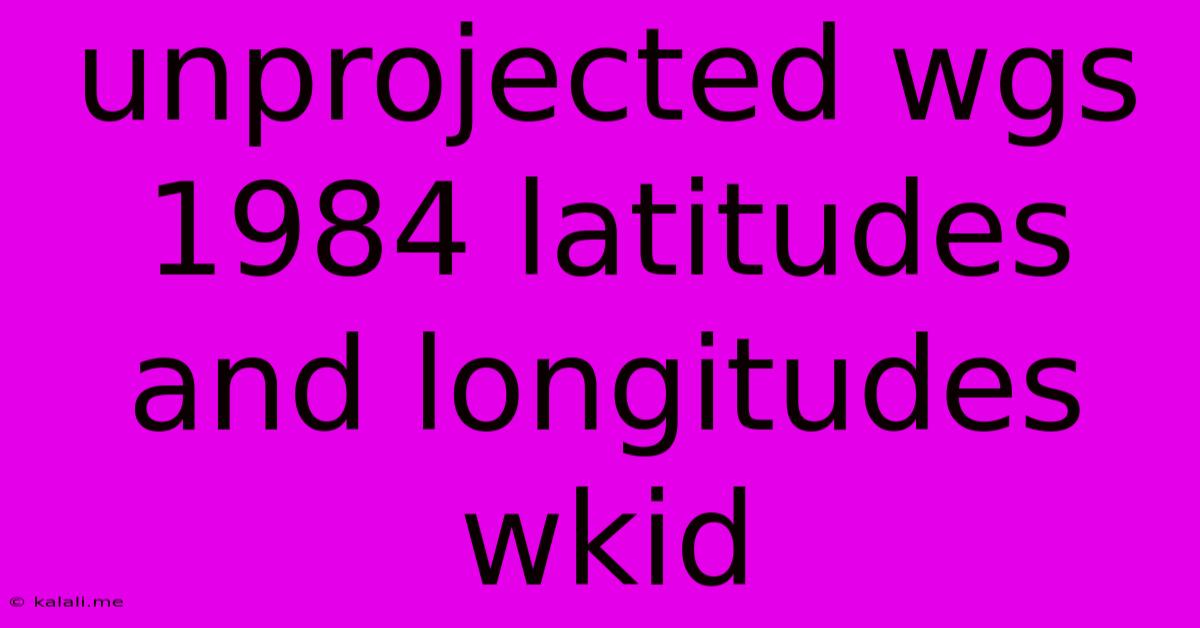Unprojected Wgs 1984 Latitudes And Longitudes Wkid
Kalali
May 31, 2025 · 3 min read

Table of Contents
Unprojected WGS 1984 Latitudes and Longitudes: Understanding WKID 4326
Geographic coordinates, expressed as latitude and longitude, form the backbone of many location-based applications and spatial datasets. Understanding the underlying coordinate reference system (CRS) is crucial for accurate data representation and processing. This article delves into the widely used WGS 1984 coordinate system, specifically its unprojected form identified by WKID 4326. We'll explore its characteristics, applications, and common misconceptions.
Meta Description: Learn about unprojected WGS 1984 coordinates (WKID 4326), their significance in GIS and mapping, and how they differ from projected coordinate systems. Understand latitude, longitude, and their applications.
What is WGS 1984?
WGS 1984 (World Geodetic System 1984) is a global coordinate system that serves as the foundation for many GPS applications and mapping systems. It's an Earth-centered, Earth-fixed (ECEF) coordinate system, meaning its origin is at the Earth's center, and it rotates with the Earth. It's crucial to note the distinction between the geodetic datum (WGS 84) and the coordinate system (latitude/longitude on WGS 84). The datum defines the shape and size of the Earth, while the coordinate system defines how locations are represented on that datum.
Unprojected vs. Projected Coordinate Systems
WGS 1984, when expressed as latitude and longitude, is considered an unprojected coordinate system. This means that the coordinates are directly represented on the Earth's surface using a spherical or ellipsoidal model. The units are degrees of latitude and longitude.
In contrast, projected coordinate systems transform the spherical Earth onto a flat surface, introducing distortions in area, shape, distance, or direction. Examples include UTM (Universal Transverse Mercator) and State Plane Coordinate Systems. These projected systems use units like meters or feet.
WKID 4326: The Identifier
WKID (Well-Known ID) 4326 is a unique identifier assigned to the unprojected WGS 1984 coordinate system. This allows GIS software and other spatial applications to unequivocally understand which coordinate system is being used. Using the correct WKID is paramount for accurate spatial analysis and data integration. Incorrect WKID assignment can lead to significant positional errors.
Applications of WGS 84 (WKID 4326)
The widespread adoption of WGS 84 (WKID 4326) stems from its versatility and global applicability. It's utilized in:
- GPS: GPS receivers provide coordinates in WGS 84.
- Mapping Applications: Many online mapping services (like Google Maps) and GIS software utilize WGS 84 as a default coordinate system.
- Geospatial Databases: Databases storing location data often use WGS 84 for its global consistency.
- Geocoding: Converting addresses to geographic coordinates usually uses WGS 84 as a target coordinate system.
Common Misconceptions
- WGS 84 is always accurate: While WGS 84 is highly accurate, local variations and the inherent limitations of representing a spherical Earth on a flat surface can still introduce minor errors.
- All latitude/longitude is WGS 84: Other geographic coordinate systems exist; specifying the datum and WKID is critical.
- WKID is the only identifier: While WKID is common, other identifiers like EPSG codes serve the same purpose.
Conclusion
Understanding the unprojected WGS 1984 coordinate system (WKID 4326) and its distinctions from projected systems is essential for anyone working with geographic data. Using the correct WKID ensures accurate data processing, integration, and analysis, avoiding costly errors in location-based applications and GIS projects. Remember always to double-check your coordinate system metadata to ensure consistency and accuracy.
Latest Posts
Latest Posts
-
You Can T Have Your Cake And Eat
Jun 01, 2025
-
Feature Class To Feature Class New
Jun 01, 2025
-
How To Adjust Norton Door Closer
Jun 01, 2025
-
Behold The Field In Which I Grow My Fucks
Jun 01, 2025
-
What Is The Sitting Position Called
Jun 01, 2025
Related Post
Thank you for visiting our website which covers about Unprojected Wgs 1984 Latitudes And Longitudes Wkid . We hope the information provided has been useful to you. Feel free to contact us if you have any questions or need further assistance. See you next time and don't miss to bookmark.